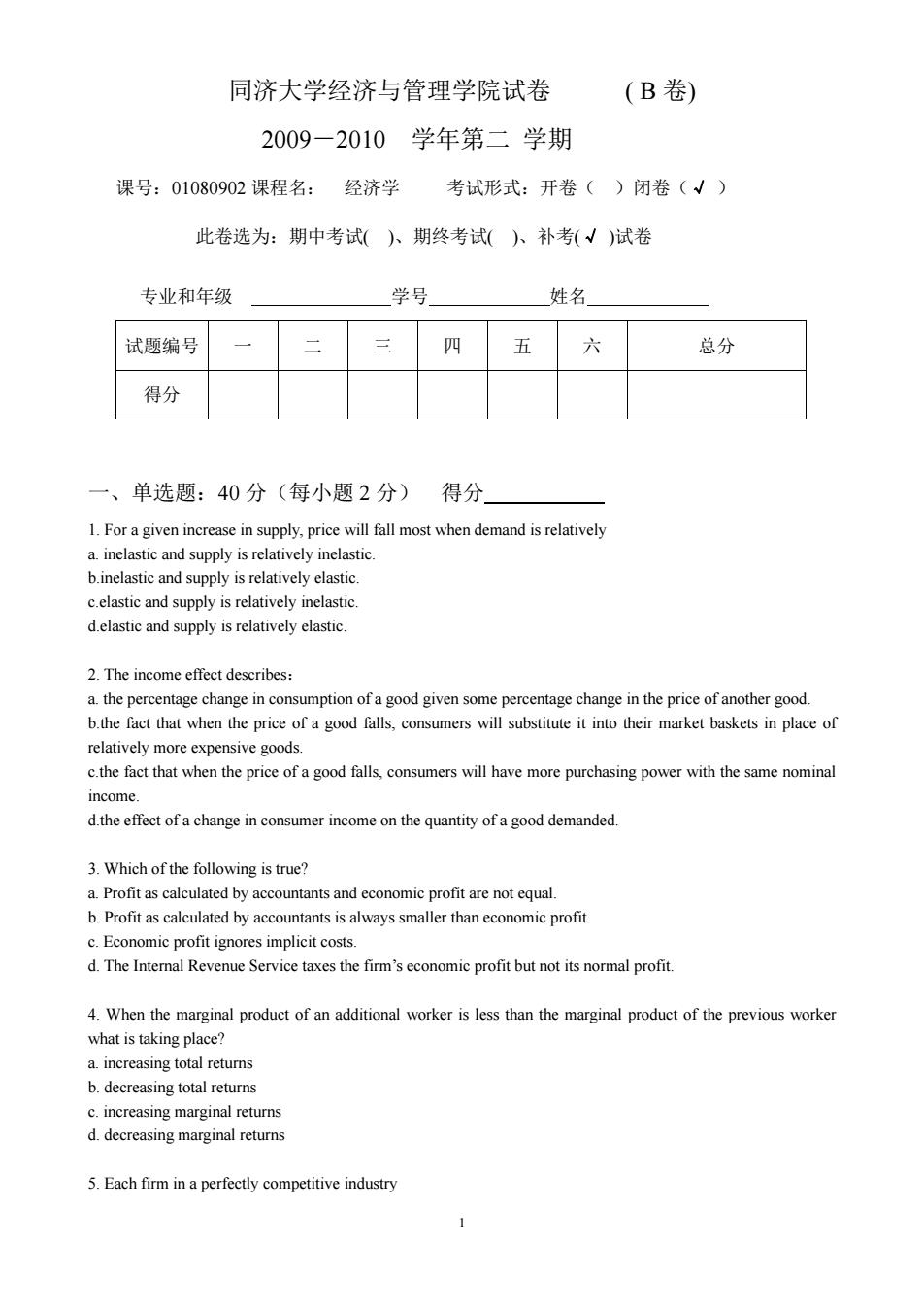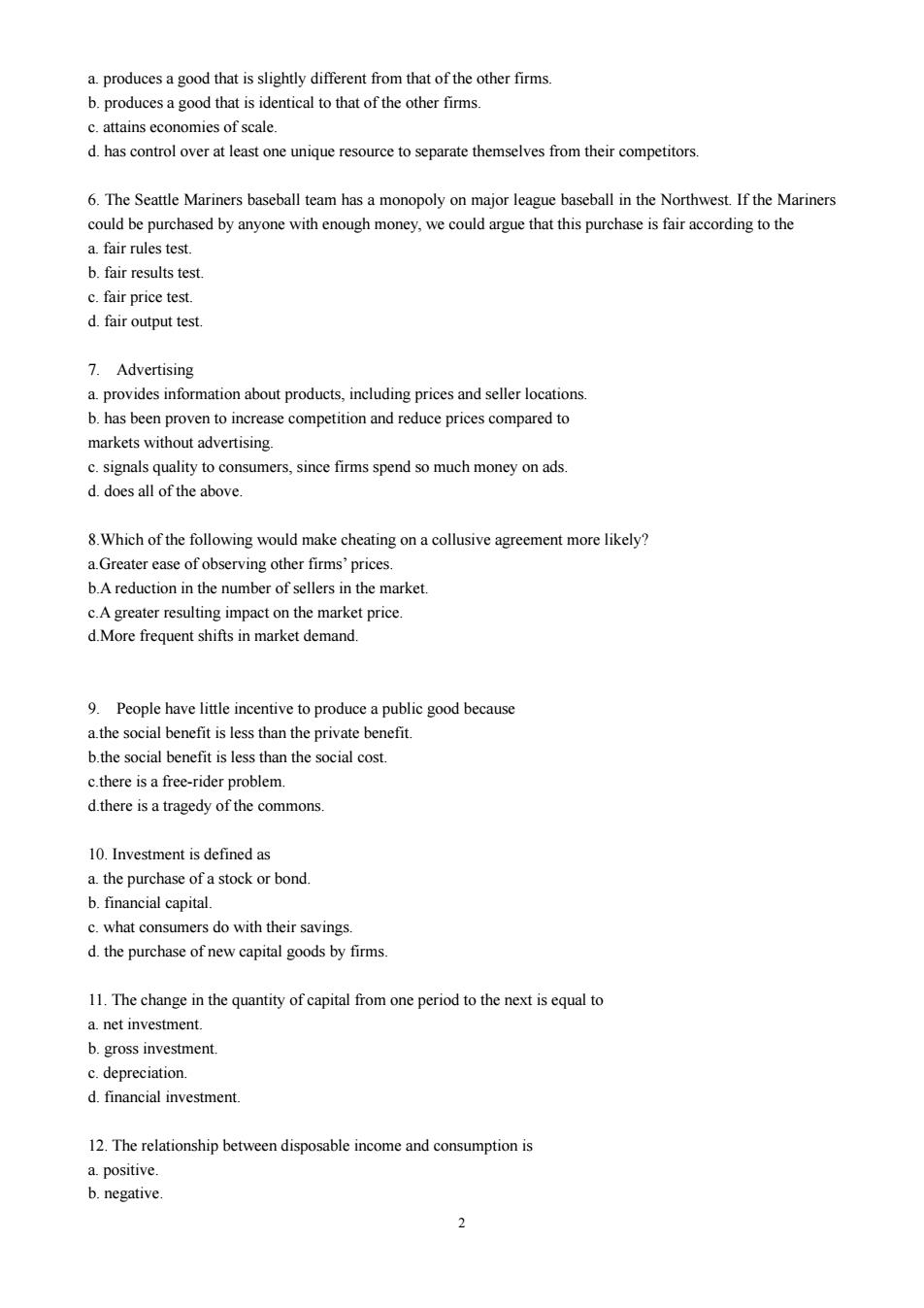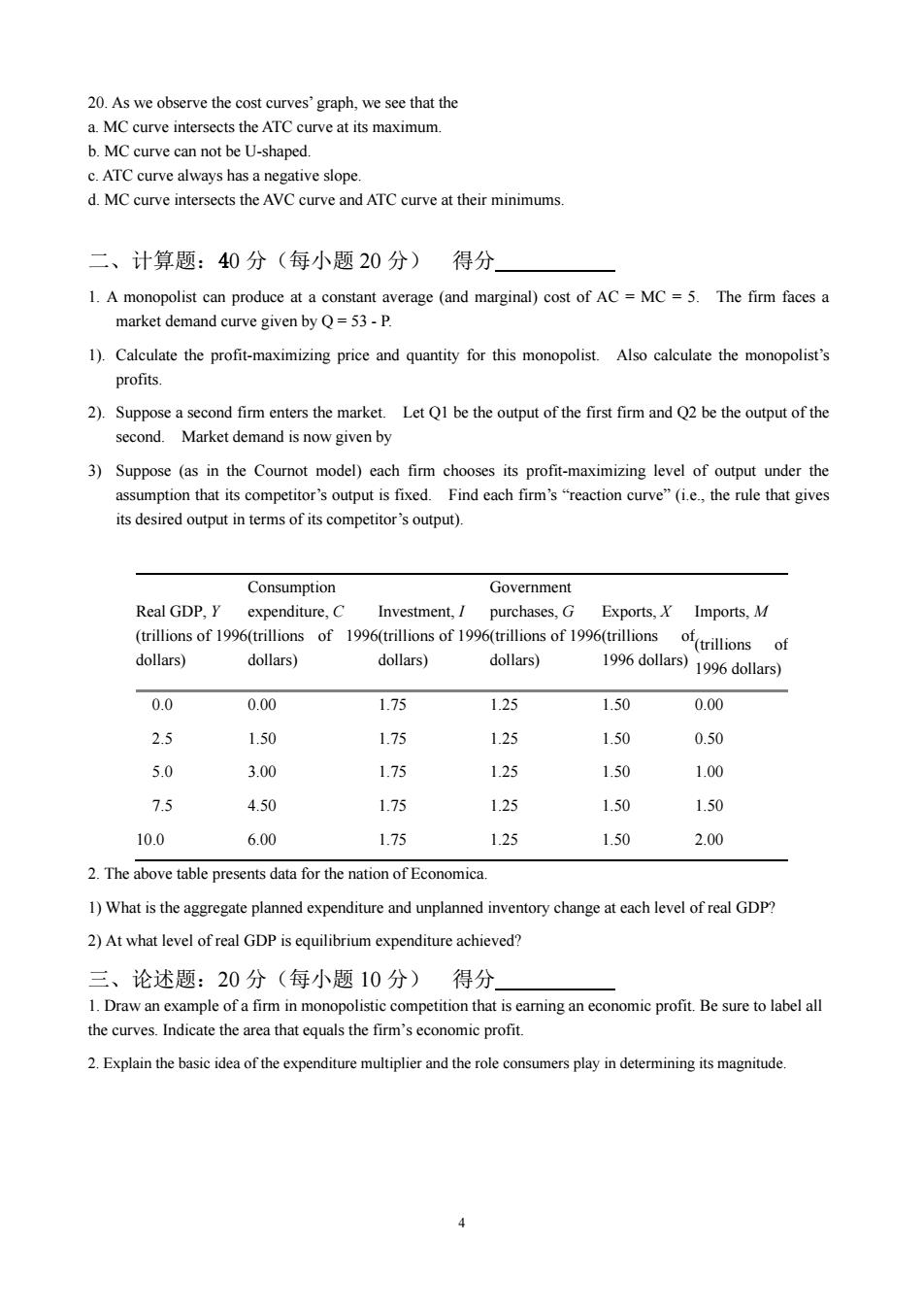
同济大学经济与管理学院试卷 (B卷) 2009-2010学年第二学期 课号:01080902课程名:经济学考试形式:开卷()闭卷(√) 此卷选为:期中考试(人期终考试(人补考(√)试卷 专业和年级 学号」 姓名 试题编号 五 总分 得分 一、单选题:40分(每小题2分)得分 1.Fora giveninrease in suppy,price will fall most when demand is relatively a.inelastic and supply is relatively inelastic. b.inelastic and supply is relatively elastic. c.elastic and supply is relatively inelastic. supply is relatively elastic 2.The income effect describes: a.the percentage change in consumption of a good given some percentage change in the price of another good. b.the fact that when the price of a good falls,consumers will substitute it into their market baskets in place of e goods cthe fact that when the price of a good falls,onsumers will have more purchasing power with the same nominal income d.the effect of a change in consumer income on the quantity of a good demanded. 3.Which of the following is true? b.Profit as calculated by accountants is always smaller than economic profit c.Economic profit ignores implicit costs. d.The Internal Revenue Service taxes the firm's economic profit but not its normal profit. 4.When the marginal product of an additional worker is less than the marginal product of the previous worker what is taking place? a.increasing total returns b.decreasing total returns c.increasing marginal returns d.decreasing marginal returns 5.Eachfirm ina perfectly competitive industry
1 同济大学经济与管理学院试卷 ( B 卷) 2009-2010 学年第二 学期 课号:01080902 课程名: 经济学 考试形式:开卷( )闭卷(√ ) 此卷选为:期中考试( )、期终考试( )、补考(√ )试卷 专业和年级 学号 姓名 一、单选题:40 分(每小题 2 分) 得分 1. For a given increase in supply, price will fall most when demand is relatively a. inelastic and supply is relatively inelastic. b.inelastic and supply is relatively elastic. c.elastic and supply is relatively inelastic. d.elastic and supply is relatively elastic. 2. The income effect describes: a. the percentage change in consumption of a good given some percentage change in the price of another good. b.the fact that when the price of a good falls, consumers will substitute it into their market baskets in place of relatively more expensive goods. c.the fact that when the price of a good falls, consumers will have more purchasing power with the same nominal income. d.the effect of a change in consumer income on the quantity of a good demanded. 3. Which of the following is true? a. Profit as calculated by accountants and economic profit are not equal. b. Profit as calculated by accountants is always smaller than economic profit. c. Economic profit ignores implicit costs. d. The Internal Revenue Service taxes the firm’s economic profit but not its normal profit. 4. When the marginal product of an additional worker is less than the marginal product of the previous worker what is taking place? a. increasing total returns b. decreasing total returns c. increasing marginal returns d. decreasing marginal returns 5. Each firm in a perfectly competitive industry 试题编号 一 二 三 四 五 六 总分 得分

a.produces a good that is slightly different from that of the other firms b.produces a good that is identical to that of the other firms. c.attains economies of scale. d.has control over at le one unique resource toseparate themselves from their competitors 6.The Seattle Mariners baseball team has a monopoly on major league baseball in the Northwest.If the Mariners could be purchased by anyone with enough money,we could argue that this purchase is fair according to the a.fair rules test b.fair results test. c.fair price test d.fair output test. 7.Advertising b.has been proven to increase competition and reduce prices compared to markets without advertising c.signals quality to consumers.since firms spend so much money on ads d does all ofthe above 8.Which of the following would make cheating onacolusive agreement more likely a.Greater ease of observing other firms'prices. b.A reduction in the number of sellers in the market c.A greater resulting impact on the market price. d.More frequent shifts in market demand 9.People have litt incentive to produce apublic good because a the social benefit is less than the private benefit b,the social benefit is less than the social cost. c.there is a free-rider problem. d there isa tragedy of the common 10.Investment is defined as a.the purchase of a stock or bond. b.financial capital. c.what consumers do with their savings d.the purchase of new capital goods by firms 11.The change in the quantity of capital from one period to the next is equal to a.net investment. b.gross investment .depreciation d.financial investment. 12.The relationship between disposable income and consumption is positive
2 a. produces a good that is slightly different from that of the other firms. b. produces a good that is identical to that of the other firms. c. attains economies of scale. d. has control over at least one unique resource to separate themselves from their competitors. 6. The Seattle Mariners baseball team has a monopoly on major league baseball in the Northwest. If the Mariners could be purchased by anyone with enough money, we could argue that this purchase is fair according to the a. fair rules test. b. fair results test. c. fair price test. d. fair output test. 7. Advertising a. provides information about products, including prices and seller locations. b. has been proven to increase competition and reduce prices compared to markets without advertising. c. signals quality to consumers, since firms spend so much money on ads. d. does all of the above. 8.Which of the following would make cheating on a collusive agreement more likely? a.Greater ease of observing other firms’ prices. b.A reduction in the number of sellers in the market. c.A greater resulting impact on the market price. d.More frequent shifts in market demand. 9. People have little incentive to produce a public good because a.the social benefit is less than the private benefit. b.the social benefit is less than the social cost. c.there is a free-rider problem. d.there is a tragedy of the commons. 10. Investment is defined as a. the purchase of a stock or bond. b. financial capital. c. what consumers do with their savings. d. the purchase of new capital goods by firms. 11. The change in the quantity of capital from one period to the next is equal to a. net investment. b. gross investment. c. depreciation. d. financial investment. 12. The relationship between disposable income and consumption is a. positive. b. negative

c.nonexistent d.not stable because it depends on whether the economy is in equilibrium or not. 13.As the interest rate increases,the opportunity cost of holding money and the quantity of money demanded a increases increases b.increases:decreases .decreases,increases d.decreases,decreases 14.When the First Bank of Townsville makes a loan.before the loan is spent its a.assets initially increase with no change in its liabilities. b.assets and liabilities increase by the exact amount of the loan ease by exact amount of the loan d.account at the Fed is immediately decreased by the amount of the loan 15.Moving along the potential GDP line,if the price level rises then a.the quantity supplied increases. c.there is nochange in potential GDP d.the potential GDP line shifts out to the right. 16.If there is a rise in the price level there is a(n)in the quantity of real gDp supplied and a movement along the AS curve a.decrease;downw b.increase;upward c.increase:downward d.decrease:upward 17.The change in supply shown in the graph above can be a result of a(n) a.increase in the real wage rate b.increase in the quantity of capital c.decrease in the money wage rate. d.decrease in the money price of oil 18.Real GDP grows when a.labor productivity increases b.labor productivity decreases c.aggregate hours decrease. d.there is an increase in mandatory vacation days 19.If the stock of physical capital (that is machinery,equipment,etc.)remains the same but the population increases.then a.labor productivity will increase. b.labor productivity will decrease the standard of nwill d.the newabor will be more productive
3 c.nonexistent. d. not stable because it depends on whether the economy is in equilibrium or not. 13. As the interest rate increases, the opportunity cost of holding money ____ and the quantity of money demanded ____. a. increases; increases b. increases; decreases c. decreases; increases d. decreases; decreases 14. When the First Bank of Townsville makes a loan, before the loan is spent its a. assets initially increase with no change in its liabilities. b. assets and liabilities increase by the exact amount of the loan. c. assets and liabilities decrease by the exact amount of the loan. d. account at the Fed is immediately decreased by the amount of the loan. 15. Moving along the potential GDP line, if the price level rises then a. the quantity supplied increases. b. the quantity supplied decreases. c. there is no change in potential GDP. d. the potential GDP line shifts out to the right. 16. If there is a rise in the price level, there is a(n) ____ in the quantity of real GDP supplied and a movement ____ along the AS curve. a. decrease; downward b. increase; upward c. increase; downward d. decrease; upward 17. The change in potential real GDP and aggregate supply shown in the graph above can be a result of a(n) a. increase in the real wage rate. b. increase in the quantity of capital. c. decrease in the money wage rate. d. decrease in the money price of oil. 18. Real GDP grows when a. labor productivity increases. b. labor productivity decreases. c. aggregate hours decrease. d. there is an increase in mandatory vacation days. 19. If the stock of physical capital (that is machinery, equipment, etc.) remains the same but the population increases, then a. labor productivity will increase. b. labor productivity will decrease. c. the standard of living will increase. d. the new labor will be more productive

20.As we observe the cost curves'graph,we see that the a.MC curve intersects the ATC curve at its maximum. b.MC curve can not be U-shaped. c.ATC curve always has a negative slope d.MC curve intersects the AVC curve and ATC curve at their minimums. 二、计算题:40分(每小题20分) 得分 1.A monopolist can produce at a constant average(and marginal)cost of AC=MC=5.The firm faces a market demand curve given by Q=53-P. 1).Calculate the profit-maximizing price and quantity for this monopolist.Also calculate the monopolist's profits 2).Suppose a second firm enters the market.Let QI be the output of the first firm and Q2 be the output of the second.Market demand is now given by 3)Suppose (as in the Cournot model)each firm chooses its profit-maximizing level of output under the assumption that its competitor's output is fixed.Find each firm's"reaction curve"(i.e.,the rule that gives its desired output in terms of its competitor's output). Consumption Government Real GDP.Y expenditure,C Investment,purchases,G Exports,X Imports,M (trillions of 1996(trillions of 1996(trillions of 1996(trillions of 1996(trillions of(trillions of dollars) dollars) dollars) dollars) 1996 dollars)1996 dollars) 0.0 0.00 1.75 1.25 1.50 0.00 2.5 1.50 1.75 1.25 1.50 0.50 5.0 3.00 1.75 1.25 1.50 1.00 7.5 4.50 1.75 1.25 1.50 1.50 10.0 6.00 1.75 1.25 1.50 2.00 2.The above table presents data for the nation of Economica 1)What is the aggregate planned expenditure and unplanned inventory change at each level of real GDP? 2)At what level of real GDP is equilibrium expenditure achieved? 三、论述题:20分(每小题10分)得分 1.Draw an example of a firm in monopolistic competition that is earning an economic profit.Be sure to label all the curves.Indicate the area that equals the firm's economic profit. 2.Explain the basic idea of the expenditure multiplier and the role consumers play in determining its magnitude
4 20. As we observe the cost curves’ graph, we see that the a. MC curve intersects the ATC curve at its maximum. b. MC curve can not be U-shaped. c. ATC curve always has a negative slope. d. MC curve intersects the AVC curve and ATC curve at their minimums. 二、计算题:40 分(每小题 20 分) 得分 1. A monopolist can produce at a constant average (and marginal) cost of AC = MC = 5. The firm faces a market demand curve given by Q = 53 - P. 1). Calculate the profit-maximizing price and quantity for this monopolist. Also calculate the monopolist’s profits. 2). Suppose a second firm enters the market. Let Q1 be the output of the first firm and Q2 be the output of the second. Market demand is now given by 3) Suppose (as in the Cournot model) each firm chooses its profit-maximizing level of output under the assumption that its competitor’s output is fixed. Find each firm’s “reaction curve” (i.e., the rule that gives its desired output in terms of its competitor’s output). Real GDP, Y (trillions of 1996 dollars) Consumption expenditure, C (trillions of 1996 dollars) Investment, I (trillions of 1996 dollars) Government purchases, G (trillions of 1996 dollars) Exports, X (trillions of 1996 dollars) Imports, M (trillions of 1996 dollars) 0.0 0.00 1.75 1.25 1.50 0.00 2.5 1.50 1.75 1.25 1.50 0.50 5.0 3.00 1.75 1.25 1.50 1.00 7.5 4.50 1.75 1.25 1.50 1.50 10.0 6.00 1.75 1.25 1.50 2.00 2. The above table presents data for the nation of Economica. 1) What is the aggregate planned expenditure and unplanned inventory change at each level of real GDP? 2) At what level of real GDP is equilibrium expenditure achieved? 三、论述题:20 分(每小题 10 分) 得分 1. Draw an example of a firm in monopolistic competition that is earning an economic profit. Be sure to label all the curves. Indicate the area that equals the firm’s economic profit. 2. Explain the basic idea of the expenditure multiplier and the role consumers play in determining its magnitude